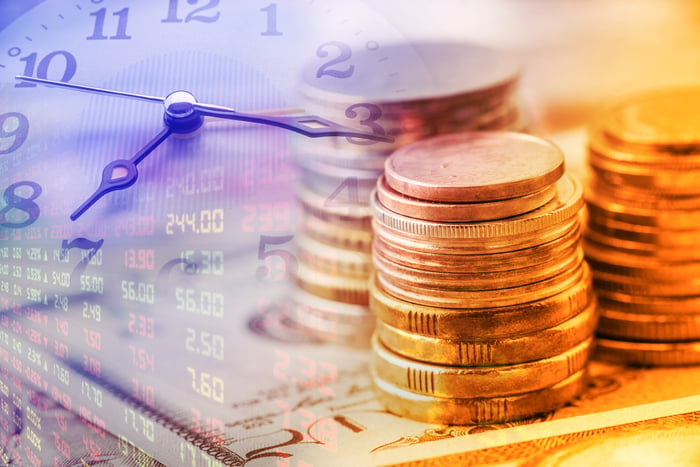It's been a whirlwind of a past six weeks for Wall Street and Main Street. Since topping out on Feb. 19, it took just over three weeks for the iconic Dow Jones Industrial Average (^DJI -0.98%) to dip into bear market territory, and just over four weeks for the 123-year-old index to shed in excess of 30% of its value. At no point in its storied history have we ever seen a 20% or 30% drop from recent high materialize so quickly.
As you're likely well aware, the spread of the coronavirus disease 2019 (COVID-19) is squarely to blame. Not only has this illness claimed more than 3,000 American lives, as of March 30, but the stringent mitigation measures put in place in a number of major cities and states threatens to bring economic activity to a halt. Over the next couple of weeks, we could see some truly jaw-droppingly bad economic data.
And yet amid the carnage, there's the solace in knowing that there will be brighter days ahead. No matter what sort of economic crisis has been thrown at the Dow Jones Industrial Average over more than a century, it's always eventually put bear markets in the rearview mirror and pushed higher. The key, of course, is that investors have to hang onto their investments for the long run to take part in these bull-market rallies.

Image source: Getty Images.
What the coronavirus crash has done is make a number of the Dow's 30 components considerably more attractive on a valuation basis. In fact, I'd go so far as to call the following three Dow stocks screaming buys.
American Express
First up is payment processing giant American Express (AXP -0.84%), which had lost as much as half of its value between the Feb. 19 peak and its March 18 trough. AmEx has found itself in Wall Street's crosshairs for two reasons. First, it's liable to see payment processing revenue decline as people hunker down in their homes and wait out the spread of COVID-19. Second, and perhaps more worryingly, American Express is also a lender, meaning it's likely to see credit delinquencies rise given the lack of economic activity and the certain rise in the unemployment rate.
While these are tangible concerns that should have a negative impact on American Express and its payment processing peers, I don't view the scenario as dire as it's been made out by Wall Street. That's because AmEx primarily seeks out more affluent clientele for its credit cards. Although this doesn't exclude the company from the pain of a rising wave of credit delinquencies, there's likely going to be less disruption for AmEx than a number of other lenders. Affluent individuals are more likely to have emergency savings, and are therefore less likely to not pay their bills.
The passage of the record $2.2 trillion CARES Act will also help small businesses, families, and working Americans meet their obligations. It's certainly not a long-term solution, but it's a step in the right direction.
Right now, investors can buy into American Express for less than 10 times next year's profit potential and roughly three times book value. It's been more than a decade since you could buy AmEx for a single-digit forward P/E ratio and nine years since you could nab this stock for three times its book value.

Image source: Getty Images.
ExxonMobil
Perhaps the ugliest sector of all during the COVID-19 crash is energy, with integrated oil and gas company ExxonMobil (XOM 0.23%) taking it on the chin. Shares of ExxonMobil are down close to 50% on a year-to-date basis with West Texas Intermediate (WTI) crude pushing down to about $20 per barrel. That's its lowest mark since 2002. With crude demand falling through the floor due to the coronavirus, and Saudi Arabia and Russia engaged in a crude-pricing war, the near-term looks ugly for oil stocks.
But there are a couple of tricks up ExxonMobil's sleeve, even in an environment where WTI is going for approximately $20 a barrel. One thing to realize is that this is a fully integrated energy company. Even though upstream drilling operations provide the bulk of ExxonMobil's growth opportunity, it's usually able to benefit from weaker crude pricing with its downstream refining and petrochemical operations. These downstream operations should come in especially handy later this year, assuming global economic activity picks back up.
ExxonMobil also has serious levers it can pull on the cost-cutting front. The company had previously pledged to spend between $30 billion and $33 billion on projects in 2020 and is obviously looking to slash this outlay by billions in the months to come. It also spent nearly $14.7 billion in 2019 paying its dividend. While I get that ExxonMobil is a Dividend Aristocrat and is likely unwilling to sacrifice its payout, it could easily conserve its cash by cutting or shelving its payout.
Currently near an 18-year low, ExxonMobil presents incredible value for long-term minded investors who can look beyond COVID-19 to an almost-certain increase in demand for fossil fuel products.

Image source: Getty Images.
JPMorgan Chase
Lastly, money-center bank JPMorgan Chase (JPM 0.15%) is looking particularly attractive after shedding more than a third of its value during this six-week swoon.
Right now, there are two big knocks against banks. First, they're a cyclical industry, and pretty much everyone on Wall Street seems convinced that we're headed for a steep, but hopefully short recession. Second, the Federal Reserve lowered its federal funds rate back to an all-time record low range of 0% to 0.25%. Put simply, it means that net interest margins for banks will be squeezed, leading to less in the way of net interest income.
But JPMorgan Chase isn't your typical bank. Among the largest national money-center banks, it's consistently vying for the No. 1 or No. 2 spot in terms of return on assets. This means it's better than most banks at generating a profit from its assets.
At the same time, JPMorgan Chase has been aggressively pushing into new markets. It's one of the few big banks to be opening up more branches than it's closing, and has been willingly spending on technology investments designed to drive digital and mobile banking. As a reminder, digital and mobile banking lead to significantly lower transaction costs for banks than in-person or even phone-based transactions.
Currently, investors can scoop up shares of JPMorgan Chase for 23% more than their book value -- that's a five-year low – and less than 9 times next year's consensus earnings per share, according to Wall Street. I'd quantify that as a screaming buy.





